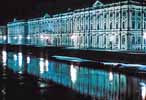

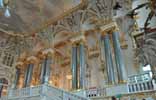
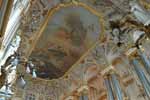



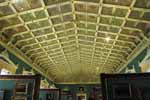
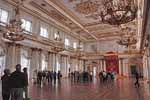
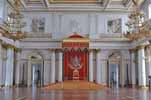
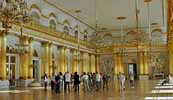
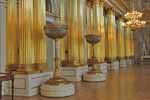
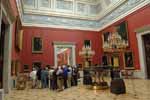

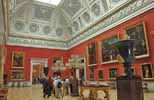
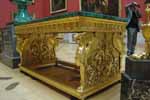
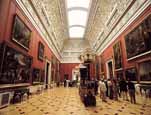
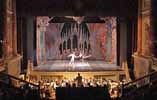
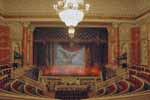
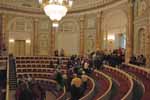

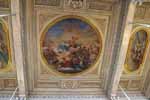
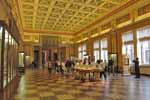


State Hermitage Museum :: Architecture and Interiors |
[Return to Index] |
The history of the museum and its buildings is complex and may best be learned from the museum's own website which has a very extensive array of images and descriptive text. See the suggestions on my opening page for the Hermitage. While the main building today, the former Winter Palace, was originally designed for Empress Elizabeth in the 1750s by the noted architect, Francesco Bartolomeo Rastrelli, each royal resident imposed his or her tastes in interior decoration. The fire of 1837, which gutted much of the building, necessitated the substantial re-design of the interiors, the work of the next two decades establishing to a considerable degree what one sees today. Thus the architecture and its decoration is the work of a century of prominent architects and painters, not one individual. My images here should be supplemented by those on the corresponding pages on the museum's website, to which links have been provided.
Click on thumbnail for full view.

| The Hermitage (Winter Palace), designed by Francesco Bartolomeo Rastrelli, 1750s, from the northwest. |



| Main staircase. Restored in 1837 by Vasilii Stasov, following original design of Francesco Bartolomeo Rastrelli. Ceiling painting by Diziano Gasparo depicting the gods of Olympus. Hermitage website. |


| Memorial Hall of Peter the Great (Small Throne Room). Designed 1833 by Auguste de Montferrand; restored 1837 by Vasilii Stasov. Painting in back of throne is Peter the Great with Minerva, by Jacopo Amiconi, 1730s. Throne made for Empress Anna Ioannovna in London by Nicholaus Klausen in 1731-1732. Hermitage website. |

| Pavilion Hall of Small Hermitage, designed by Andrei Stakenschneider, mid-19th c. Hermitage website. |

| The Tent Hall, New Hermitage, designed by Leo von Klenze. Hermitage website. |


| St. George Hall (Large Throne Room), restored and substantially altered by Vasilii Stasov after 1837 fire. Hermitage website, |


| Armorial Hall designed by Vasilii Stasov, late 1830s. Hermitage website. |


| Spanish Skylight Hall, designed by Leo von Klenze 1851. Hermitage website. |


| Small Italian Skylight Hall, designed by Leo von Klenze, mid-19th c. Hermitage website. |

| Large Italian Skylight Hall, designed by Leo von Klenze, mid-19th c. Hermitage website. |



| The Hermitage Theater, designed by Giacomo Quarenghi, 1783-1789. Hermitage website. |


| The Leonardo Room. Designed by Andrei Stackenschneider, 1858. Hermitage website. |

| The Majolica Room in the New Hermitage, designed Leo von Klenze, mid-19th c. Hermitage website. |

| The Raphael Loggias, the paintings supervised by Christoph Unterberger in 18th c. Hermitage website. |

| Ah, to be an art student in St. Petersburg! |